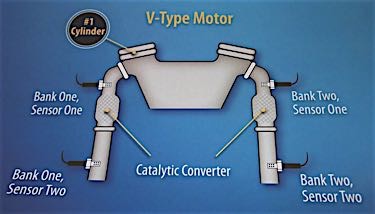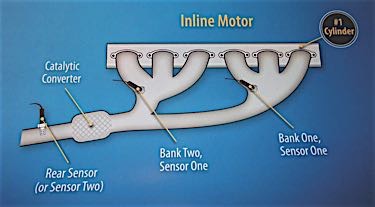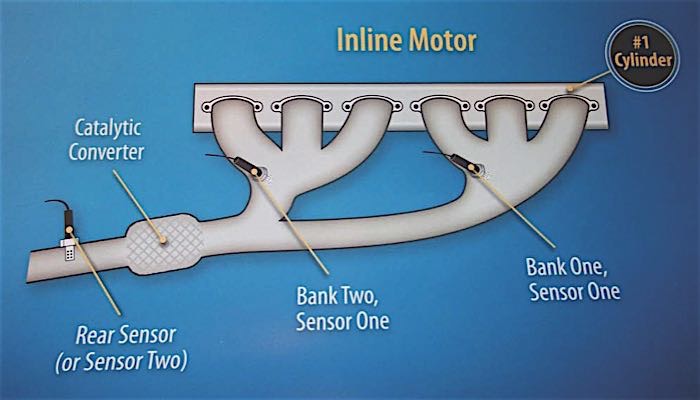
The key to locating bank one/sensor one, is to identify the #1 engine cylinder.
In a V-type motor (see Photo 1), sensor one is in the exhaust system before the catalytic converter.
In an inline motor (see Photo 2), the rear sensor (or sensor two) is in the exhaust system after the catalytic converter.

Using a 10-megaohm digital voltmeter, hook up the voltmeter’s red probe to the sensor’s signal wire and the black probe to engine ground. Note: Use the back-probe method, do not pierce the wire.
1. Start the engine and let it idle for about two minutes while watching the digital reading on the voltmeter. It should be fixed for a short period at around 0.1 or 0.2 volts.
2. After two or three minutes, the voltage reading will begin to fluctuate between 0.1 and 0.9 volts. If the sensor takes four minutes or more to begin fluctuating, replace it.
3. Record the lowest and highest voltage reading from the voltmeter in any one-minute period. The voltage should fluctuate constantly between 0.1 and 0.9 volts.
4. Replace the oxygen sensor if the voltage:
• Goes above this range,
• Remains below 0.5 volts, or
• Stays fixed at a particular voltage
5. Open and close the engine throttle with a quick motion. The sensor’s output voltage should go up and down accordingly.
The O2 sensor normally alternates between zero volts and one volt.
If the O2 sensor voltage is fixed at one volt, check for these rich air-fuel ratio conditions:
- Plugged air filter
- Faulty ECU
- Faulty air mass meter
- Faulty MAP sensor
- Faulty idle control valve
- Faulty fuel pressure regulator
- Faulty fuel injectors
- Restricted fuel return line
- Fouled spark plugs
- Faulty ignition wires
- Ignition timing
- Faulty oxygen sensor
- Faulty air fuel sensor
- Faulty EVAP
- Associated wiring
- Engine coolant temperature
If the O2 sensor voltage is fixed at zero volts, check for these lean air-fuel ratio conditions:
- Vacuum leak
- Faulty ECU
- Faulty air mass meter
- Faulty air flow meter
- Faulty MAP sensor
- Faulty idle control valve
- Faulty fuel pressure regulator
- Faulty fuel pump
- Restricted fuel filter
- Faulty fuel injectors
- Faulty PCV Associated wiring
- Exhaust gas leak
- Faulty oxygen sensor
- Faulty air fuel sensor
- Ignition timing
- EGR valve
Courtesy of Denso.














